
![]()
Volume 5, No. 3
Promoting Cooperation to Maintain and Enhance
Environmental Quality in the Gulf of Maine
|
||||||||||
|
Regular columns |
|
Current stories |
|
Archives |
|
About |
Coastal community programs have changed the way Atlantic Canadians think about their water
By Andi Rierden, editor
Water quality. It is a topic that generally stirs interest only when tragedies occur like the one in Walkerton, Ontario, last year, where seven people died of E. coli contamination. But long before Walkerton, and discoveries of the bacteria in wells across North America, the community-rooted Atlantic Coastal Action Programs (ACAP) were exposing the harsh truth about the region's strained watersheds and pushing for change.
The idea to establish community bases to educate and solve coastal water problems took flight in the late 1980s, when a group of government and academic scientists created the Clean Annapolis River Project (CARP) in Nova Scotia. Before long, a cadre of CARP volunteers called the River Guardians began monitoring the Annapolis River and publicizing the data in reports, in the local media and on billboards placed along the river.
Steven Hawboldt, a former newspaper editor who grew up in the Annapolis Valley, was hired in 1990 as the organization's first program director. He ran the organization from a sun porch at his home.
"We started with no money, but a lot of enthusiasm and a vision," recalls Hawboldt, who today manages the Annapolis Royal nonprofit with a small staff from offices in the town's historic section. CARP later became the model for ACAP, launched by Environment Canada in 1991. Eventually the program grew to 14 sites throughout Atlantic Canada. While Environment Canada continues to give technical and expert advice and a small amount of financing to each site, for the most part, ACAPs chart their own course and raise funding from government, nonprofit and private sources.
The four Bay of Fundy/Gulf of Maine ACAPs monitor an agricultural corridor, an international estuary and the largest watershed in the Gulf of Maine. To mark the tenth anniversary of ACAP, the Gulf of Maine Times visited the sites to sample current projects. Below is a snapshot of what we found.
Clean Annapolis River Project, Annapolis Royal, Nova Scotia
www3.ns.sympatico.ca/c.a.r.p
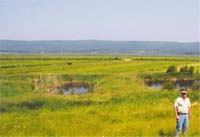
With the help of CARP, David Brown had a wetland constructed in his field to filter and purify waste from his cattle. Photo: Andi Rierden.
Dave Brown's 325-acre cattle farm in Upper Clements, Nova Scotia, is a testament to ecological agriculture. A former Royal Canadian Mounted Police officer, Brown returned home 12 years ago from northern Manitoba to take over the family farm. Not far from the mouth of the Bay of Fundy, Northview Farms rests between the highland called South Mountain and the historic dikes running along the Annapolis River. With more than 150 head of beef and dairy cattle, Brown was determined to prevent run-off from the milkhouse and manure storage area from contaminating streams and groundwater. After talking with the staff at CARP, Brown agreed to have a special wetland constructed in one of his fields to filter the waste. As part of the design, wastewater is channeled into three separate ponds before being discharged into a marsh. Cattails and other florae found in natural wetlands further purify by uptaking the nutrients from the waste, resulting in cleaner water.
Today this oasis in a sea of grasslands attracts red-winged black birds,
bobolinks, fox, muskrats, waterfowl and other wildlife, an added bonus for
Brown, who serves as president of a nonprofit park for injured animals that
cannot return to the wild.
"People may think that farming is harmful to the environment but most
farmers love the land and are trying to move away from the unsanitary
practices of the past," Brown says. "Finding the resources to do it is key."
Through CARP, other farmers in the Annapolis Valley have benefited from
similar projects.
Up the river in Bridgetown, two of CARP's River Guardians, Ron Jones and Shelley Pittman, sample the water at one of 12 sites along the Annapolis. Billboards at the sites broadcast the level of bacteria found in the river and the results are published monthly in area newspapers.
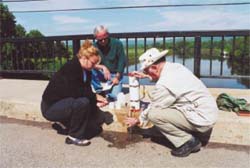 Steven
Hawboldt (in back) with Shelly Pittman and Ron Jones, testing the waters on
the Annapolis River in Nova Scotia. Photo: Andi Rierden.
Steven
Hawboldt (in back) with Shelly Pittman and Ron Jones, testing the waters on
the Annapolis River in Nova Scotia. Photo: Andi Rierden.
Over the years, some 200 volunteers have collected water quality data from the Annapolis watershed and educated residents about fecal coliform and other river contaminants and the importance of maintaining septic systems.
As a result, the river's quality has improved markedly, Hawboldt says, but it still has a long way to go. "The single largest problem is inadequate septic systems," he says, adding that while CARP has no regulatory powers, it can still have a bold impact. "Regulations alone are not going to do it," he says. "Particularly in a rural community where residents may not have the financial means. You have to get people to buy into the reality that it is critically important to their community and to themselves to take care of their septic systems."
CARP also served as the catalyst for a plan to construct a wetland for the Town of Annapolis Royal. The project, which is being constructed by Ducks Unlimited, will eventually provide tertiary treatment to further purify discharge from the town's sewage operation. Similar projects throughout Canada and the United States have proven to be an effective wastewater treatment method. "This project is going to be a big boon for wildlife, for the community and for the river," Hawboldt says.
ACAP Saint John, Saint John, New Brunswick
http://user.fundy.net/acapsj
Sean Brillant is leading a visitor through the dewy grasses along the banks of Marsh Creek in the east end of Saint John. Despite its tranquil name, this is not a site for the fainthearted. Sandwiched between a railroad line and a business strip, the once thriving waterway and outlet for the Saint John River is in big trouble. Iridescent sheens of creosote float by. Piles of debris such as a rusted shopping cart and toilet paper litter the waters. Untreated sewage from hundreds of homes and contaminants from a local hospital spew out of a half dozen outfall pipes all along the creek's lower end - about 800,000 gallons of the toxic stew a day, Brillant says. Not surprisingly, the stench is close to unbearable.
Brillant picks up a rock and hurls it into a bank coated with a shiny black muck. "Those are PAHs," he says, referring to polycyclic aromatic hydrocarbons, which are chemicals found predominantly in petroleum products like creosote. They are known carcinogens.
Five years ago, ACAP volunteers took samples from the creek and found that the levels of fecal coliform and chemical contaminants increased from one end of the marsh to the other. One sample site revealed hydrocarbons at 700,000 parts per million, or 3,000 times more than the guideline for recreational swimming. By the time the volunteers reached the lower end of the creek they discovered that the banks and waters were oozing with creosote - the legacy of a long gone wood treatment plant. Brillant pauses along this same spot long enough to sigh and shake his head. "This is like our Sydney tar ponds," he says referring to the notorious toxic waste site in Sydney, Nova Scotia
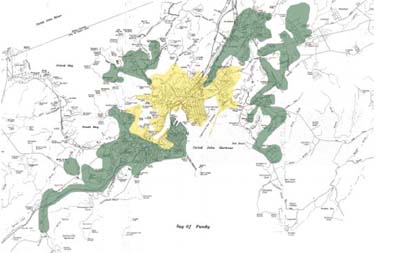
ACAP St. John displays a map similar to the one above
in its front window on busy St. Germain Street, indicating where sewage is
treated (in green) and not treated (in yellow). Courtesy of ACAP St. John
Driving down Rothesay Avenue toward cleaner waters, Brillant explains that the responsibility of cleaning up the site has become a game of cat and mouse between the city, provincial and federal governments. For its part, ACAP Saint John has hammered away at the issue by releasing several technical reports documenting the creek's toxicity and generating dozens of interviews to the regional media.
Publicizing the lethal mess at lower Marsh Creek is part of Saint John ACAP's large-scale strategy to propel the city into cleaning up its harbor. As it stands, about 50 percent of the wastewater flushed from Saint John households' spills into the harbor untreated. That means the sewage produced by 65,000 residents, mostly in the city's core, flows straight into streams, rivers and the harbor.
Brillant points out that the city continues to make strides like committing $2 million (US $1.3 million) annually to sewage treatment. As a result of a $6 million (US $3.9 million) investment five years ago, waste from 6,000 homes along the Western Beaches region of the city is now treated. Still, he adds, the city would need around $109 million (US $70.8 million) to complete the job and the federal government has, so far, dragged its feet.
While the average rate of sewage treatment for all of Canada is about 92 percent, Atlantic Canada falls way behind. Saint John is ahead of some cities in the Maritimes, but drops behind other Canadian cities. While Moncton and Fredericton, New Brunswick treat all of their wastewater, more than 100 million liters (26 million gallons) of raw sewage is discharged into Halifax, Nova Scotia's harbor each day (the harbor's watershed contains two municipal treatment plants and some industrial treatment plants). St. John's, Newfoundland, doesn't treat one drop.
"A city that does not treat its sewage does not respect the environment and that is unacceptable in this day and age," Brillant says. "It's time we stopped degrading our waterway."
Eastern Charlotte Waterways, Inc., St. George, New Brunswick
www.ecwinc.org
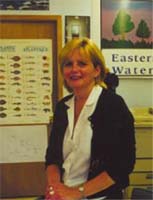 Susan
Farquharson at Eastern Charlotte Waterways, Inc. in St. George, New
Brunswick. Photo: Andi Rierden.
Susan
Farquharson at Eastern Charlotte Waterways, Inc. in St. George, New
Brunswick. Photo: Andi Rierden.
When visiting the offices of Eastern Charlotte Waterways Inc. (ECW) watch out for Forrest and Flora, the resident red-eared slider turtles. They often roam through the offices when not swimming in their tank and help to draw in the younger set. Young or old, visitors will feel right at home here. Scented candles flicker next to bowls of candy and lively colors splash the walls and doorways. The homey atmosphere inside this Main Street storefront in St. George is precisely what Susan Farquharson had in mind when she took over as executive director five years ago. True to the ACAP spirit, ECW's "drop on in" style makes it a hub for locals and other passersby looking for the lowdown on issues facing southeastern New Brunswick.
When federal cutbacks forced Environment Canada to limit its monitoring of local shellfish harvesting areas, ECW offered to help by creating a bacterial monitoring program in 1997. "The industry couldn't afford to lose more harvesting areas to closures," she says. "And unless the areas are monitored they remain closed." Working with Environment Canada and the Canadian Food Inspection Agency, a trained staff member assisted by volunteers measures the weight, length and numbers of clams in specific areas. Water samples from the areas are analyzed for fecal coliform, dissolved oxygen, nutrients, temperature and salinity. Clam meats are also analyzed for bacterial contamination.
Taking the process a step further, ECW works with a social service agency to help residents finance septic system upgrades or replacements. The program entails door to door surveys and education sessions.
Last fall, Wendy Raymond, a field technician for ECW, interviewed residents on Grand Manan Island about their systems. Households with septic problems were sent a follow-up letter alerting them to the availability of financing through a low-interest loan program. "People were very open to talking about their systems," Raymond says. "The community realizes it is a major problem."
Indeed. ECW estimates that overall, 60 to 70 percent of New Brunswick households have degraded septic systems. In a section of Grand Manan, for example, systems often do not contain a leaching field to filter waste before it is discharged. "In the evenings my wife and I will go for a walk and ditch after ditch," is filled with human waste, says one resident Raymond queried. In a recent telephone interview, the man added that his mother, a widow, and her neighbor discharge their waste into a common ditch. "It's disgusting," the man says. "My father used to clean it out but he's been dead for years." The man said he hopes to obtain financial assistance to help his mother purchase a new system with a leaching field installed.
Another resident says his property is too narrow to contain a field and that waste from his home is discharged into the Bay of Fundy. One of his wells, he adds, contains E. coli. "I've got too many bills to pay and just can't deal with it now," the man says. ECW is working on a plan to install a communal sewage system for residents without room for drainage fields, Raymond says.
Sitting inside ECW's offices on a late weekday afternoon, Farquharson says the economic, health and psychological issues surrounding the septic problem require pooling help from several agencies. Getting people to comply is often a challenge, but attitudes are changing, Farquharson says, adding, "Our role here is not to dictate. We're not here to turn people off, we're here to say 'you are part of the community and we need you to be involved."
St. Croix Estuary Project, St. Stephen, New Brunswick
www.scep.org
When Art MacKay was a boy growing up in St. Stephen, New Brunswick, the St. Croix Estuary often glowed from bonfires built along its banks by fishermen to attract smelt. He remembers fishing for flounder and sitting on the beach at Oak Bay watching the herring flash through the water. There were large runs of striped bass, a commercial eel and gaspereau fishery.
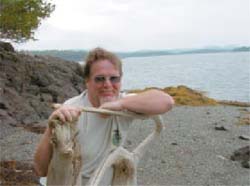 SCEP's
president, Art MacKay, talks passionately "to everyone I meet" about the St.
Croix waterway. Photo: Karen MacKay
SCEP's
president, Art MacKay, talks passionately "to everyone I meet" about the St.
Croix waterway. Photo: Karen MacKay
"I grew up in St. Stephen at the tail end of what once was," MacKay, the
president of the St. Croix Estuary Project (SCEP), says. "Then came the
awful 60s."
That was about the time, he continues, when the Georgia Pacific pulp and
paper mill in Woodland, Maine, "began dumping caustic chemicals into the
river beyond belief. They blew out the commercial and recreational fisheries
and literally killed the river. It was a very difficult time."
The company (which recently sold the mill to Domtar Inc., a Canadian concern) has made exemplary strides in cleaning up the river, MacKay says, as have a long list of groups from both sides of the border. Yet once again, the river is increasingly threatened; this time, by residential development.
The St. Croix is designated as a Canadian Heritage River and as a Class A river by the State of Maine (from Spednic Lake to Oak Point). The U.S./Canadian boundary is set at midstream down the entire length of the river. With members from both sides of the border sitting on its board of directors, SCEP has for years monitored the health of the watershed and shared its data with regulatory agencies on both sides.
With funding from the International Joint Commission, New Brunswick Environment Trust Fund and ACAP, SCEP is expanding its research activities by developing a model monitoring program and classification system with several permanent sampling stations positioned along the St. Croix waterway. MacKay says the program will help determine long-term changes in the estuary through an annual analysis of pollutants and bacteria in its mudflats, fauna and water.
The data will also give SCEP more muscle in pushing to remediate human disturbances to the watershed. Last year, after several residents told MacKay about mysterious foam near the Oak Bay causeway near St. Stephen, he and Mark Bader, SCEP's executive director, investigated. "Indeed it was phosphate [detergent] foam," MacKay says. "You could taste it."
Before the causeway was built in the 1950s, there were only a handful of houses on either side of the Bay. "Now you've got a ton of cottages draining into the bay and filling the groundwater with septic and dumpings like washing machine detergent," he continues. Studies and observations conducted by SCEP have shown a steep decline in mysis shrimp, sticklebacks and mummichogs from the bay, which are the mainstay for foraging birds and fish such as flounder. MacKay says household discharges are at least partly responsible.
"If you know the area at all you'll see that the blue herons and osprey are hardly around anymore because there are no flounder or smaller fish left to feed on." At the same time, oyster beds are appearing in the Bay, which indicates the water may be getting warmer. "The whole biology of the area is shifting," MacKay says.
The causeway should be breached and a small bridge built over it to allow
the reservoir to flush, he continues, but that may be complicated
considering that the reservoir is used as a swimming pond by a local
campground. Harking back to the conundrum faced by all ACAPs, MacKay asks,
then answers his own question:
"So how do you attack all of these non-point sources of pollution and still
be a community organization? I talk passionately about the river to everyone
I see and tell them how great it was and what we have to do to get it back
to that point.
| Community bases form the core Before ACAP came on the scene, the task of measuring the bacterial levels in Nova Scotia's water was assigned mostly to local public health departments, although the information was not made public. Dr. Graham Daborn, the director of the Acadian Centre for Estuarine Research at Acadia University, says the lack of public awareness about contaminants in the river was a major cause for concern.
Along with other academic and government scientists Daborn formed the Atlantic Estuary Cooperative Venture in the late 1980s, which in turn created the Clean Annapolis River Project. CARP's River Guardians immediately began monitoring the river and making its findings public. "One of the first things that came out was just how badly sewage management was being dealt with," he says. "The exposure [by CARP] led to a substantial upgrade of municipal wastewater treatment plants and ultimately improved the river's quality." CARP set the groundwork for the Atlantic Coastal Action Programs, in Daborn's mind, a novel and necessary move. "When we set up ACAP we were not looking at it as a way of deflecting responsibility from central government," he says. "We were thinking of community bases as the only way we could effectively change environmental conditions. While it is assumed that big business or industry are the main polluters, in fact, it is what individuals do on their own land that is more significant." Daborn adds that ACAP's biggest challenges are still ahead. "Climate change may present real uncertainties for agriculture. There is more talk about extensive irrigation¾pumping the groundwater up onto the surface. And if you drilled a well in the middle of a field where cattle are kept, there is a much greater risk that the waste will run down the pipe and straight into the groundwater. We must get a handle on preserving water that is not yet contaminated. Groundwater presents our last reserve." |
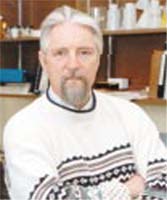 Dr.
Graham Daborn
Dr.
Graham Daborn